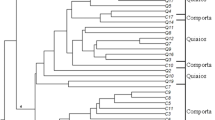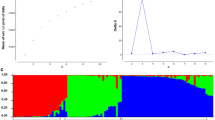Abstract
The present study used 15 simple sequence repeat loci to characterize the genetic diversity of the germplasm that originated the current industrial chicory and to establish the relationships between and inside Cichorium intybus L. and Cichorium endivia L. Initially we analyzed 19 cultivated C. endivia accessions, 27 wild and 155 cultivated C. intybus accessions distributed among three groups: 83 root chicories, 42 Witloof and 30 leaf chicories. The leaf chicories comprised cultivars corresponding to the Radicchio, Sugarloaf and Catalogne subgroups. The latter has not been previously included in any genetic diversity study. Subsequently, 1297 individuals from the 15 modern root chicory cultivars at the origin of the breeding of the current industrial root chicory cultivars were analyzed. Although the accessions of C. endivia and C. intybus were clearly separated from each other, seven wild C. intybus individuals were genetically closer to C. endivia than to C. intybus, revealing complex genetic interrelationships between these species. The differentiation of C. intybus into three cultivar groups (Witloof, root chicory and leaf chicory) was confirmed. The leaf chicory individuals were divided into three genetic subgroups, corresponding to the Radicchio, Sugarloaf and Catalogne cultivars, thus attesting to the validity of the classification based on morphological factors. Clear differentiation was observed among the Belgian, Polish and Austrian modern industrial root cultivars, but not among the French industrial modern root cultivars. The high phenotypic and genetic variability of the modern industrial root cultivars indicates that this germplasm constitutes a useful gene pool for cultivar improvement and selection.




Similar content being viewed by others
Abbreviations
- AFLP:
-
Amplified fragment length polymorphism
- AMOVA:
-
Analysis of molecular variance
- Dps:
-
Distance proportion of shared alleles
- F st :
-
Fixation index
- ITS:
-
Internal transcribed spacer
- PIC:
-
Polymorphism index content
- SSR:
-
Simple sequence repeat
- PCA:
-
Principal component analyses
- UPGMA:
-
Unweighted pair group method with arithmetic mean
References
Baes PG, Van Cutsem PJ (1993) Isozyme polymorphism in three gene pools of cultivated chicory (Cichorium intybus L.). Euphytica 71:143–150
Bellamy A, Vedel F, Bannerot H (1996) Varietal identification in Cichorium intybus L. and determination of genetic purity of F1 hybrid seed samples, based on RAPD markers. Plant Breed 115:128–132
Bowcock AM, Ruiz-Linares A, Tomfohrde J, Minch E, Kidd JR, Cavalli-Sforza LL (1994) High resolution of human evolutionary trees with polymorphic microsatellites. Nature 68:455–457
Chessel D, Dufour AB, Thioulouse J (2004) The ade4 package—I: one-table methods. R News 4:5–10
Dauchot N, Raulier P, Maudoux O, Notté C, Bertin P, Draye X, Van Cutsem P (2014) Mutations in chicory FEH genes are statistically associated with enhanced resistance to post-harvest inulin depolymerization. Theor Appl Genet 127:125–135
De Proft M, Van Stallen N, Veerle N (2003) Breeding and cultivar identification of Cichorium intybus L. var. foliosum Hegi. In: Van Hintum ThJL, Lebeda A, Pink D, Schut JW (eds) Eucarpia leafy vegetables. Centre for Genetic Resources, Wageningen, pp 83–90
Doré C, Varoquaux F (2006) Histoire et amélioration de cinquante plantes cultivées. Institut national de la recherche agronomique, Paris
Evanno G, Regnaut S, Goudet JG (2005) Detecting the number of clusters of individuals using the software STRUCTURE: a simulation study. Mol Ecol 14:2611–2620
Excoffier L, Lischer HEL (2010) Arlequin suite ver 3.5: a new series of programs to perform population genetics analyses under Linux and Windows. Mol Ecol Resour 10:564–567
Gemeinholzer B, Bachmann K (2005) Examining morphological and molecular diagnostic character states of Cichorium intybus L. (Asteraceae) and C. spinosum L. Plant Syst Evol 253:105–123
Hamilton MB, Pincus EL, Di Fiore A, Fleischer RC (1999) Universal linker and ligation procedures for construction of genomic DNA libraries enriched for microsatellites. Biotechniques 27:500–502
Hammer K, Gladis TH, Laghetti G, Pignone D (2013) Cichorium intybus L. as a root vegetable in Italy and remarks on the infraspecific classification of the cultivated races of this species. Int J AgriSci 3(12):928–937
Jombart T (2008) Adegenet: a R package for the multivariate analysis of genetic markers. Bioinformatics 24:1403–1405
Kiær LP, Philipp M, Jørgensen RB, Hauser TP (2007) Genealogy, morphology and fitness of spontaneous hybrids between wild and cultivated chicory (Cichorium intybus). Heredity 99:112–120
Kiær LP, Felber F, Flavell A, Guadagnuolo R, Guiatti D, Hauser TP, Oliviery AM, Scotti I, Syed N, Vichi M, van de Wiel C, Jørgensen RB (2009) Spontaneous gene flow and population structure in wild and cultivated chicory, Cichorium intybus L. Genet Resour Crop Evol 56:405–419
Kiers AM (2000) Endive, chicory, and their wild relatives, a systematic and phylogenetic study of Cichorium (Asteraceae). PhD thesis, Universiteit Leiden, Leiden
Kiers AM, Mes THM, van der Meijden R, Bachmann K (1999) Morphologically defined Cichorium species reflect lineages based on chloroplast and nuclear (ITS) DNA data. Syst Bot 24:645–659
Kiers AM, Mes THM, van der Meijden R, Bachmann K (2000) A search for diagnostic AFLP markers in Cichorium species with emphasis on endive and chicory cultivar groups. Genome 43:470–476
Koch G, Jung C (1997) Phylogenetic relationships of industrial chicory varieties revealed by RAPDs and AFLPs. Agronomie 17:323–333
Lucchin M, Varotto S, Barcaccia G, Parrini P (2008) Chicory and endive: genetics and breeding. In: Prohens J, Carena MJ, Nuez F (eds) Vegetables I: Asteraceae, Brassicaceae, Chenopodicaceae, and Cucurbitaceae. Springer, Berlin, pp 3–48
Muys C, Thienpont C-N, Dauchot N, Maudoux O, Draye X, Van Cutsem P (2013) Integration of AFLPs, SSRs and SNPs markers into a new genetic map of industrial chicory (Cichorium intybus L. var. sativum). Plant Breed 133:130–137
Nei M (1972) Genetic distance between populations. Am Nat 106:283–292
Nei M (1973) The theory and estimation of genetic distance. In: Morton NE (ed) Genetic structure of populations. University Press of Hawaii, Honolulu, pp 45–54
Paradis E, Claude J, Strimmer K (2004) APE: analyses of phylogenetics and evolution in R language. Bioinformatics 20:289–290
Pritchard JK, Stephens M, Donnelly P (2000) Inference of population structure using multilocus genotype data. Genetics 155:945–959
R Development Core Team (2013) R: A language and environment for statistical computing. R Foundation for Statistical Computing, Vienna, Austria. http://www.R-project.org/
Rick CM (1953) Hybridization between chicory and endive. Proc Am Soc Hort Sci 61:459–466
Rumball W (1986) Grassland Puna’s chicory (Cichorium intybus L.). NZ J Exp Agric 14:105–107
Sørensen BS, Kiær LP, Jørgensen RB, Hauser TP (2007) The temporal development in a hybridizing population of wild and cultivated chicory (Cichorium intybus L.). Mol Ecol 16:3292–3298
Van Cutsem P, du Jardin P, Boutte Beauwens T, Jacqmin S, Vekemans X (2003) Distinction between cultivated and wild chicory gene pools using AFLP markers. Theor Appl Genet 107:713–718
Van Kruistum G (1997) Witlof en roodlof. Teelthandleiding 79:11–13
Van Stallen N, Noten V, Neefs V, de Proft M (2001) The phylogenetic relationship between different Cichorium intybus cultivars and cultivar groups, as revealed by RAPDs. Plant Breed 120:425–428
Vermeulen A, Desprez B, Lancelin D, Bannerot H (1994) Relationships among Cichorium species and related genera as determined by analyses of mt RFLPs. Theor Appl Genet 88:159–166
Acknowledgments
The authors acknowledge the Walloon Region (DGARNE-Belgium) for supporting this research (Grant D31-1221).
Conflict of interest
O. Maudoux and C. Notté are employees of Cosucra-Groupe Warcoing S.A.
Author information
Authors and Affiliations
Corresponding author
Electronic supplementary material
Below is the link to the electronic supplementary material.
10722_2015_244_MOESM1_ESM.pdf
Supplementary material E.S.M. 1 (A & B) Principal component analysis (PCA) of the C. endivia and C. intybus cultivar groups (first panel). The red square corresponds to the wild C. intybus individuals from Iraq, Pakistan, and the Syrian Arab Republic. (C) PCA of the Witloof group only. (D) PCA of the leaf chicory cultivars. (PDF 12 kb)
10722_2015_244_MOESM2_ESM.pdf
Supplementary material E.S.M. 2 Principal component analysis of the 15 modern industrial chicory cultivars (second panel). Numbers in ellipses represent the 95% confidence interval of the different groups (PDF 105 kb)
Rights and permissions
About this article
Cite this article
Raulier, P., Maudoux, O., Notté, C. et al. Exploration of genetic diversity within Cichorium endivia and Cichorium intybus with focus on the gene pool of industrial chicory. Genet Resour Crop Evol 63, 243–259 (2016). https://doi.org/10.1007/s10722-015-0244-4
Received:
Accepted:
Published:
Issue Date:
DOI: https://doi.org/10.1007/s10722-015-0244-4




